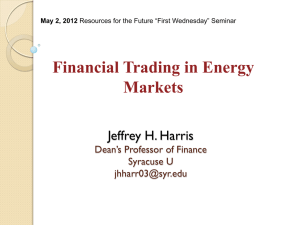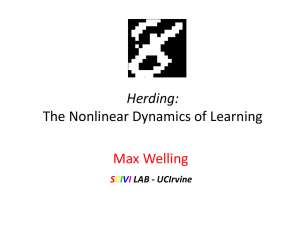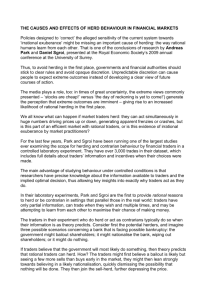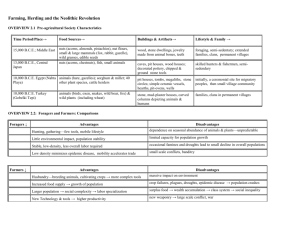Herding, Contrarianism and Delay in Financial Market Trading A Lab Experiment
advertisement
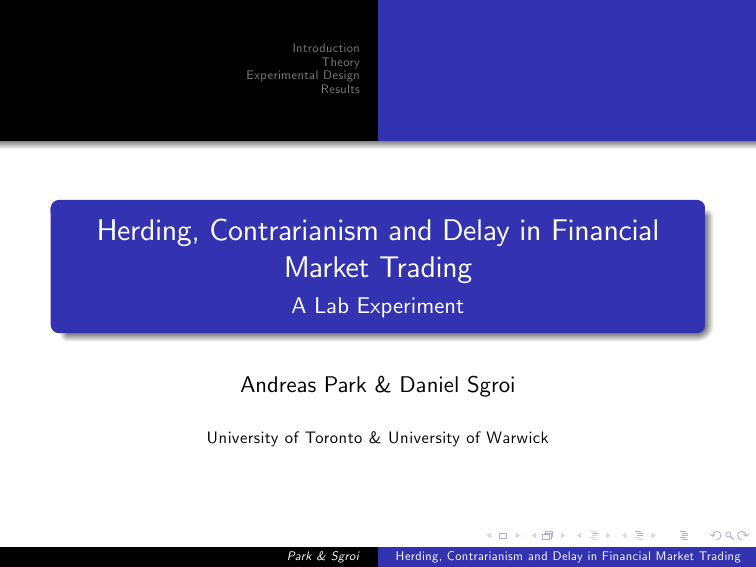
Introduction Theory Experimental Design Results Herding, Contrarianism and Delay in Financial Market Trading A Lab Experiment Andreas Park & Daniel Sgroi University of Toronto & University of Warwick Park & Sgroi Herding, Contrarianism and Delay in Financial Market Trading Introduction Theory Experimental Design Results Two Restaurants E¢ cient Prices Classic Herding Example: Two Restaurants People have private information about which of two restaurants (A or B) is better. They arrive in sequence and can observe predecessors’actions. The …rst follows his signal (say A). The second knows the …rst’s signal, and his own (say A, hence goes for A). The third can disregard his own and will herd to restaurant A. 1 If he had a B this would cancel with the …rst signal, leaving agent 3 looking to agent 2, hence opting for A. A fortiori if he had an A signal. Consequence: from agent 3 onwards herding is possible! Park & Sgroi Herding, Contrarianism and Delay in Financial Market Trading Introduction Theory Experimental Design Results Two Restaurants E¢ cient Prices What About Prices? Sticking with the 2 state/2 action world of the restaurant example, let’s consider traders deciding whether to buy or sell a stock. Informationally e¢ cient prices automatically incorporate public information about actions, leaving only private information as a means of pro…t. For instance, with a single price: pt = E [V jHt ], so pro…t comes from E [V jHt , St ] E [V jHt ]. [With a spread we need noise traders to allow pro…ts since the market can take into account the action of the trader]. We seem to have lost the potential for herding! Park & Sgroi Herding, Contrarianism and Delay in Financial Market Trading Introduction Theory Experimental Design Results Basic Setup Market Maker De…nitions Rational Herding and Contrarianism Conditional Signal Distributions Theorem Timing One Trade Two Trades Objectives Basic Setup Asset value V 2 fV1 , V2 , V3 g = f75, 100, 125g . Pr (V1 ) = Pr (V2 ) = Pr (V3 ) . Traders of two types: 1 2 Informed (subjects, 75%: can buy, sell or hold as they wish); Noise (computer traders, 25%: buy or sell with equal probability). Informed receive private conditionally iid signal S 2 fS1 , S2 , S3 g about V wlog ordered S1 < S2 < S3 and can observe the prior history of actions Ht . Optimal rational choice for informed (assuming indi¤erent agents buy) is buy if E [V jHt , St ] price, otherwise sell. Park & Sgroi Herding, Contrarianism and Delay in Financial Market Trading Introduction Theory Experimental Design Results Basic Setup Market Maker De…nitions Rational Herding and Contrarianism Conditional Signal Distributions Theorem Timing One Trade Two Trades Objectives Market Maker Trade is organized by a market maker. In theory he posts a bid-price (at which he buys) and an ask-price (at which he sells). To keep it simple in the experiment we have a single price for all trades pt = E [V jHt ]. Subjects know that he will adjust price upwards with a buy and down with a sell. Park & Sgroi Herding, Contrarianism and Delay in Financial Market Trading Introduction Theory Experimental Design Results Basic Setup Market Maker De…nitions Rational Herding and Contrarianism Conditional Signal Distributions Theorem Timing One Trade Two Trades Objectives De…nitions A trader rationally engages in herd-buying (herd-selling) after a history of trade Ht i¤: 1 2 3 he would sell (buy) at the initial history H1 ; he buys (sells) at history Ht ; prices at Ht are higher (lower) than at H1 . A trader rationally engages in buy-contrarianism (sell-contrarianism) after a history Ht i¤: 1 2 3 he would sell (buy) at the initial history H1 ; he buys (sells) at history Ht ; prices at Ht are lower (higher) than at H1 . Park & Sgroi Herding, Contrarianism and Delay in Financial Market Trading Introduction Theory Experimental Design Results Basic Setup Market Maker De…nitions Rational Herding and Contrarianism Conditional Signal Distributions Theorem Timing One Trade Two Trades Objectives Rational Herding and Contrarianism Consider exogenous-time (a strict sequence). If S2 types have decreasing or increasing csds they cannot herd or be contrarian (they become similar to S1 and S3 types respectively). Herding candidates must receive information that makes their decisions more volatile and so they distribute weight to the tails of their beliefs - we call this U-shaped information. Contrarian candidates behave in a stabilizing manner, distributing weight towards the centre of their beliefs - we call this hill-shaped information. Park & Sgroi Herding, Contrarianism and Delay in Financial Market Trading Introduction Theory Experimental Design Results Basic Setup Market Maker De…nitions Rational Herding and Contrarianism Conditional Signal Distributions Theorem Timing One Trade Two Trades Objectives Conditional Signal Distributions Park & Sgroi Herding, Contrarianism and Delay in Financial Market Trading Introduction Theory Experimental Design Results Basic Setup Market Maker De…nitions Rational Herding and Contrarianism Conditional Signal Distributions Theorem Timing One Trade Two Trades Objectives Theorem From Park & Sabourian (2008), for exogenous-time (strict sequences) we have: Types S1 and S3 never herd or act in a contrarian manner. Type S2 buy(sell)-herd i¤ his csd is negative(positive) U-shaped. Type S2 buy(sell)-contrarian i¤ his csd is negative(positive) hill-shaped. Park & Sgroi Herding, Contrarianism and Delay in Financial Market Trading Introduction Theory Experimental Design Results Basic Setup Market Maker De…nitions Rational Herding and Contrarianism Conditional Signal Distributions Theorem Timing One Trade Two Trades Objectives Timing So far (and in all existing theoretical and expermental studies into …nancial herding) we require that traders wait in line until it is their turn to trade. That’s not what happens in reality — they choose both how and when to trade. This is especially important since timing and herding may be linked. For the static decision of how to trade we continue with the exogenous-time theory, for the dynamic decision we have some further observations. They are both part of a single problem but we separate them for expositional clarity. Park & Sgroi Herding, Contrarianism and Delay in Financial Market Trading Introduction Theory Experimental Design Results Basic Setup Market Maker De…nitions Rational Herding and Contrarianism Conditional Signal Distributions Theorem Timing One Trade Two Trades Objectives One Trade Smith (AER 2000) has a single trader setup and shows that trade immediately if information is either good or bad news (=“monotonic” signals in our language); also has example of U-shaped signal which mandates delay. Hypothesis 1: S1 and S3 should trade immediately when markets open, S2 should trade later. Hypothesis 2: (weaker) S1 and S3 should trade before the S2 . Hypothesis 3: Hill-shape (= more convinced) trades before U-shape (= less convinced). Park & Sgroi Herding, Contrarianism and Delay in Financial Market Trading Introduction Theory Experimental Design Results Basic Setup Market Maker De…nitions Rational Herding and Contrarianism Conditional Signal Distributions Theorem Timing One Trade Two Trades Objectives Two Trades With two trades there is really no theory! Best guess: Hypothesis 4: S1 and S3 should trade before the S2 . Hypothesis 5: No speculative trading (=buy-sell)? Park & Sgroi Herding, Contrarianism and Delay in Financial Market Trading Introduction Theory Experimental Design Results Basic Setup Market Maker De…nitions Rational Herding and Contrarianism Conditional Signal Distributions Theorem Timing One Trade Two Trades Objectives Objectives We will run an experiment to test: whether the informational structure matters (theorem); whether timing matters (hypoheses 1-5). Park & Sgroi Herding, Contrarianism and Delay in Financial Market Trading Introduction Theory Experimental Design Results Treatments Time-line The Trading Software Numbers Treatements negative U-shape ) buy-herding; negative hill-shape ) buy-contrarianism; positive U-shape ) sell-herding; negative hill-shape + two trades ) buy-contrarianism; positive U-shape + two trades ) sell-herding; negative U-shape + two trades ) buy-herding. Park & Sgroi Herding, Contrarianism and Delay in Financial Market Trading Introduction Theory Experimental Design Results Treatments Time-line The Trading Software Numbers Time-line Initial instructions including hand-outs that could be viewed at any time. The existence and proportion of noise-trades explained, and subjects are told what S1 , S2 and S3 signals mean prior to each treatment (so they "understand" all the signals not just the ones they receive). For each treatment they are given the full signal matrix and the posterior for each signal at H1 and then signals handed out via the computer. Subjects can act whenever they wish within a 3 minute time period, with regular announcements of time available. Noise traders act at random times. Park & Sgroi Herding, Contrarianism and Delay in Financial Market Trading Introduction Theory Experimental Design Results Treatments Time-line The Trading Software Numbers The Trading Software Traders can always see their signal, current price and the history of prices (actions). Park & Sgroi Herding, Contrarianism and Delay in Financial Market Trading Introduction Theory Experimental Design Results Treatments Time-line The Trading Software Numbers Numbers We ran 13 sessions in total (3 at UCambridge, 6 at UWarwick, 4 at UToronto). Group sizes were 13-25. 1993 trades. By type: 623 (S1 ), 786 (S2 ), 584 (S3 ); Single trade: 683 with 197 S1 , 276 S2 and 210 S3 ; Two trades: 1310 with 426 S1 , 510 S2 and 374 S3 . Park & Sgroi Herding, Contrarianism and Delay in Financial Market Trading Introduction Theory Experimental Design Results Overall Fit Herding vs Contrarianism Herding Contrarianism Absolute Timing Relative Timing Behavioral Explanations Conclusion Overall Fit The rational (exoegnous-time) model explains about 73% of trades (comparable to other herding studies, even those without prices). [In a sister paper focusing on exogenous-time in the lab this number was 75%]. Herding candidates are less well explained by the rational model (54%). Assuming di¤erent levels of risk aversion doesn’t improve …t ) risk neutrality a fair assumption. Park & Sgroi Herding, Contrarianism and Delay in Financial Market Trading Introduction Theory Experimental Design Results Overall Fit Herding vs Contrarianism Herding Contrarianism Absolute Timing Relative Timing Behavioral Explanations Conclusion Herding vs Contrarianism We check whether U-shape/hill-shape signi…cant source for herding/contrarianism: herdi ,t contrai ,t = α + βu-shapei ,t + …xedi + ei ,t , = α + βhill-shapei ,t + …xedi + ei ,t Park & Sgroi Herding, Contrarianism and Delay in Financial Market Trading Introduction Theory Experimental Design Results Overall Fit Herding vs Contrarianism Herding Contrarianism Absolute Timing Relative Timing Behavioral Explanations Conclusion Herding Herding Logit OLS OLS …xed e¤ects Observations all types 0.292** (-0.022) 0.378** (-0.025) 0.352** (-0.027) 1172 T1-T3 0.114** (-0.032) 0.138** (-0.039) 0.081 (-0.042) 391 Park & Sgroi T4-T6 …rst trade second trade 0.397** (-0.032) 0.495** (-0.031) 0.434** (-0.038) 781 T4-T6 0.228** (-0.025) 0.293** (-0.03) 0.276** (-0.032) 805 T4-T6 0.446** (-0.05) 0.552** (-0.043) 0.545** (-0.057) 367 Herding, Contrarianism and Delay in Financial Market Trading Introduction Theory Experimental Design Results Overall Fit Herding vs Contrarianism Herding Contrarianism Absolute Timing Relative Timing Behavioral Explanations Conclusion Contrarianism Contra Logit OLS OLS …xed e¤ects Observations all types 0.361** (-0.056) 0.434** (-0.057) 0.406** (-0.063) 820 T1-T3 0.304** (-0.081) 0.353** (-0.085) 0.300* (-0.117) 293 Park & Sgroi T4-T6 …rst trade second trade 0.419** (-0.082) 0.508** (-0.079) 0.473** (-0.108) 527 T4-T6 0.358** (-0.064) 0.439** (-0.066) 0.405** (-0.076) 553 T4-T6 0.371** (-0.114) 0.429** (-0.114) 0.655** (-0.177) 267 Herding, Contrarianism and Delay in Financial Market Trading Introduction Theory Experimental Design Results Overall Fit Herding vs Contrarianism Herding Contrarianism Absolute Timing Relative Timing Behavioral Explanations Conclusion Absolute Timing Type S trading systematically before type S 0 can be interpreted that the distribution of trading times for type S is …rst order stochastically dominated by that of type S 0 . Graphically, the cdf of S lies above the cdf of S 0 . Stark example: if traders have two trades then the …rst trades typically occur before their …rst trade when they have only one trade: Park & Sgroi Herding, Contrarianism and Delay in Financial Market Trading Introduction Theory Experimental Design Results Park & Sgroi Overall Fit Herding vs Contrarianism Herding Contrarianism Absolute Timing Relative Timing Behavioral Explanations Conclusion Herding, Contrarianism and Delay in Financial Market Trading Introduction Theory Experimental Design Results Park & Sgroi Overall Fit Herding vs Contrarianism Herding Contrarianism Absolute Timing Relative Timing Behavioral Explanations Conclusion Herding, Contrarianism and Delay in Financial Market Trading Introduction Theory Experimental Design Results Park & Sgroi Overall Fit Herding vs Contrarianism Herding Contrarianism Absolute Timing Relative Timing Behavioral Explanations Conclusion Herding, Contrarianism and Delay in Financial Market Trading Introduction Theory Experimental Design Results Overall Fit Herding vs Contrarianism Herding Contrarianism Absolute Timing Relative Timing Behavioral Explanations Conclusion Relative Timing Relative proximity: The percentage of trades that follow within 1.5 seconds of another. All times total time >5 sec total time >10 sec total time >20 sec total time >30 sec All 67% 58% 54% 51% 50% S1 66% 56% 52% 48% 44% Park & Sgroi S2 63% 57% 53% 51% 50% S3 71% 62% 58% 55% 54% hill 64% 57% 55% 56% 56% ve U 66% 60% 55% 50% 49% +ve U 61% 55% 50% 49% 46% Herding, Contrarianism and Delay in Financial Market Trading Introduction Theory Experimental Design Results Overall Fit Herding vs Contrarianism Herding Contrarianism Absolute Timing Relative Timing Behavioral Explanations Conclusion 0 200 Frequency 400 600 800 Frequency of Time-differences 0 5 10 time difference Park & Sgroi 15 20 Herding, Contrarianism and Delay in Financial Market Trading Introduction Theory Experimental Design Results Overall Fit Herding vs Contrarianism Herding Contrarianism Absolute Timing Relative Timing Behavioral Explanations Conclusion Behavioral Explanations Most alternative behavioral models tested did not add much to insight or …t, except one inspired by level K-belief (Costa-Gomes et al 2001) & QRE (McKelvey & Palfrey 1995) which add a rational reaction to irrationality. Step 1: Assume fraction δ of other subjects act rationally. δ = 2/15 maximizes …t, increasing it from 70% (‘pass’=wrong) to 73% (equiv. to actual noise level 90%). Step 2: Assume fraction 1 δ of other subjects act irrationally and δ react rationally to the irrationality. Best …t for δ = 0 (no updating); good …t from T1-T3 for δ = 0.22. With 0.22 improvement from T1-T3 is 69.8% to 76.1%. Park & Sgroi Herding, Contrarianism and Delay in Financial Market Trading Introduction Theory Experimental Design Results Overall Fit Herding vs Contrarianism Herding Contrarianism Absolute Timing Relative Timing Behavioral Explanations Conclusion Conclusion Behavior is largely consistent with static (exogenous-time) theory for S1 and S3 , less for S2 so static models have something to o¤er for real-world predictions. Herding and contrarian signals are the signi…cant source of herding and contrarianism. Having such a signal increases the chance of herding by 30% and 36% respectively (the e¤ect of the Herd signal is much stronger than in exogenous time framework (a mere 6%)). Most behavioral theories don’t greatly improve the …t, though a variation on level-k/QRE is useful. Park & Sgroi Herding, Contrarianism and Delay in Financial Market Trading Introduction Theory Experimental Design Results Overall Fit Herding vs Contrarianism Herding Contrarianism Absolute Timing Relative Timing Behavioral Explanations Conclusion Conclusion (continued) Absolute timing: S1 and S3 trade systematically before the S2 . Hill shape trades before U-shape. With two trades allowed, trading occurs earlier. Relative timing: there is evidence of clustering, but does not depend on information. Other results: Prices do have an e¤ect: the larger the price, the less likely traders are to buy (end-point e¤ect). Return trading occurs. Park & Sgroi Herding, Contrarianism and Delay in Financial Market Trading
